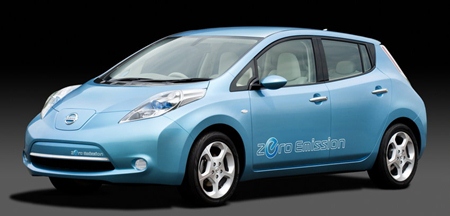Far from electric cars taking over from the internal combustion engine, comes the news that Better Place, the battery swap specialists, has filed for bankruptcy.
Better Place and Renault became partners, which looked to be a mutually rewarding deal. Renault was making all electric cars (the Leaf and the Fluence) and was sure they would sell over 100,000 cars in Israel and Denmark by 2016. Unfortunately, the public did not embrace the electric concept and only 1,000 cars have been sold so far. This was not enough to keep the battery exchange company going, and now Better Place is not in a better place!
 Nissan Leaf
Nissan Leaf
With no signs of the world’s oil reserves running out, despite all the scare mongering of a few years ago, motorists do not see the pressing need to buy a non-polluting motor vehicle. CO2 emissions mean nothing to the average joe either. Electric cars are not yet dead in the water, but until there is a shortage of fuel, the electric cars will remain the province of the dyed in the wool conservationists, and there are not that many prepared to pay extra for an electric car.
The study ‘Drive Green 2020: More Hope than Reality’ concluded global hybrid and EV demand is likely to account for only a small proportion of total vehicle sales over the next decade, despite multi-billion-dollar investments and fast-paced development in the car industry, according to global marketing information company JD Power and Associates who commissioned the research.
JD Power’s research postulates that hybrids and EVs combined will account for just 7.3 percent – or 5.2 million units – of the 70.9 million passenger vehicles forecast to be sold in 2020. In other words, 92 percent of new vehicles at the end of the next decade will still be gasoline/diesel powered. So much for the oil supply dwindling. JD Power’s study obviously does not feel we will be forced into driving EVs.
Dealing in ‘futures’ is at best a risky business, and some automakers who have placed their bets on the end of oil as we know it, have commenced development of EVs. Nissan-Renault, for example, is expecting EVs alone to account for around 10 percent of total vehicle sales by the end of the decade – while JD Power estimate only 1.8 percent. But even if we accept Nissan-Renault’s figures, that still leaves 90 percent conventional gasoline/diesel power.
JD Power is not the only voice calling for caution. The consulting firm Deloitte, estimated in August this year that the EV sales in the US in 2020 would account for just 3.1 percent (465,000 units) of total automotive sales in that market. These two studies definitely point towards difficulties in convincing the public to switch from conventionally powered passenger vehicles to either hybrids or EVs over this coming decade. They also show confidence that the oil supply will still be plentiful in 2020, but there is no real forecast figure as to how much a barrel of crude might cost.
With EV sales expected to be very small, the vast majority of the green sales will be hybrids, mostly from Toyota (64 percent) and Honda (25 percent) and with sales concentrated Japan (446,000 units) and the US (328,000).
Of the 5.2 million hybrids and EVs expected to be sold by 2020, almost 75 percent of the total are expected to be hybrids – and 75 percent of these are forecast to be produced by Toyota, Honda, Hyundai, Volkswagen and General Motors.
The leading markets for the hybrids by 2020 are expected to be the US (1.7 million units), Europe (977,000) and Japan (875,000).
So where is China in all these scenarios? JD Power suggests China is expected to sell fewer than 100,000 hybrids in 2020. It is, however, expected to account for 332,000 of the 1.3 million EV sales forecast in 2020, which is behind Europe (on 742,000, a figure that makes the German government’s plan look optimistic) but ahead of both the US and Japan (both on around 100,000 units).
In the meantime, the financial boffins now have to work out what to do with the 38 Better Place exchange depots in Israel and the 17 in Denmark.




